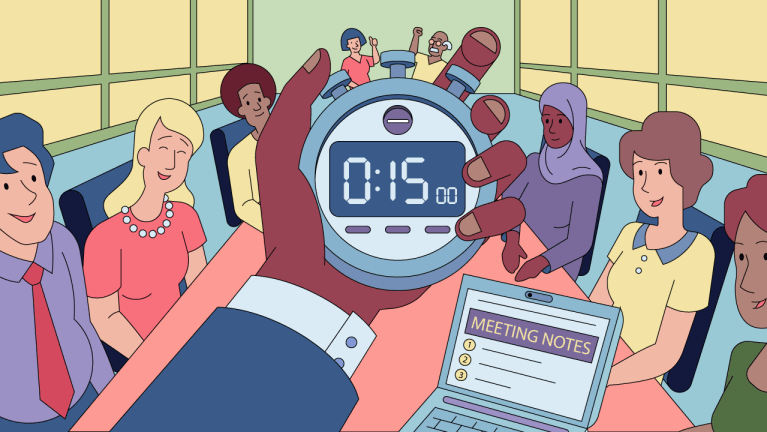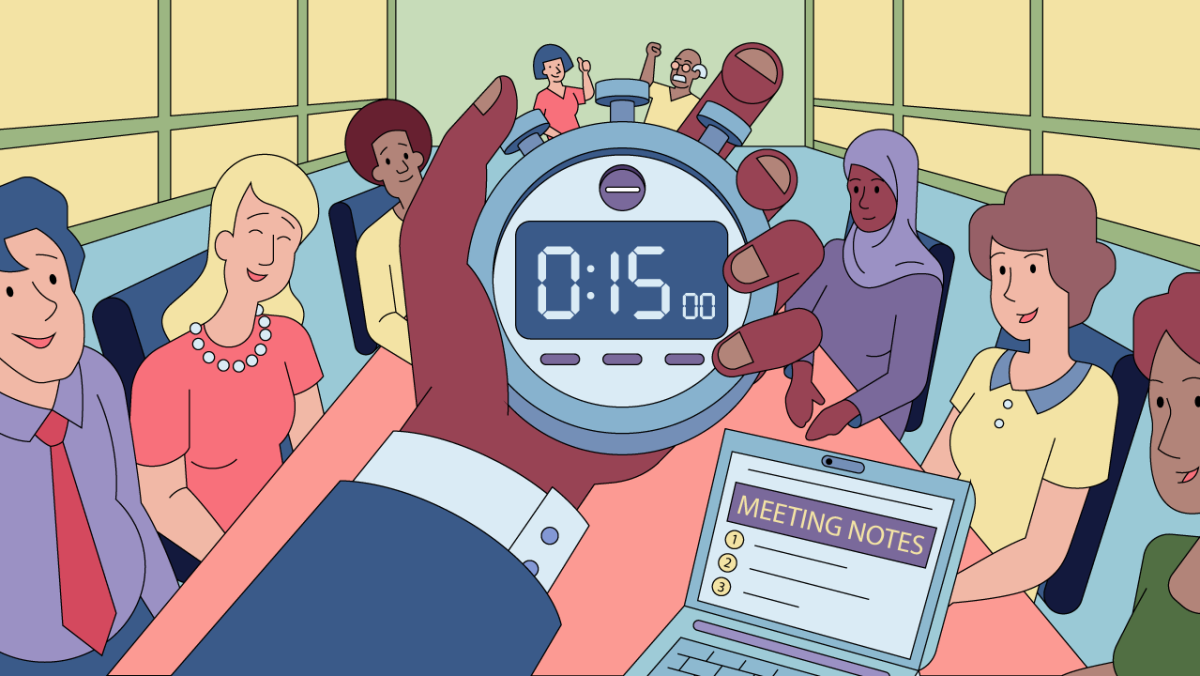

Few people, from the summer intern right up to the boardroom elite, like workplace meetings. Case in point: Billionaire Mark Cuban once told Inc. magazine, “The only way you’re going to get me for a meeting is if you’re writing me a check.”
Cuban is hardly alone. Tesla founder Elon Musk calls meetings a “blight,” and a now infamous 2015 Harris survey found that 17 percent of employees would rather watch paint dry and 8 percent would rather undergo a root canal than attend a meeting.
Managers aren’t wild about meetings, either, and they’re the ones who usually have to run them.
One way to make workplace gatherings more efficient and productive is to implement the “15-minute meeting.” This approach was first introduced by Berlin-based financial automation company Monite in July 2021, when the organization put in place a quarter-hour limit for managers running team meetings.
Business experts say the 15-minute meeting curbs employee burnout and boosts engagement, with which many companies have been struggling since embracing hybrid or fully remote work arrangements as a result of the pandemic.
“Fifteen-minute meetings are prime sources of efficiency,” says Dannie Lynn Fountain, a Google talent sourcer and founder of Focused on People, a human resource services company in Seattle. Research shows that 65 percent of U.S. employees agree that meetings prevent them from completing their own work, while 24 billion hours are wasted each year as the result of unproductive meetings, she notes.
For managers, learning how to plan for and run shorter meetings is good for business.
“The 15-minute meeting allows managers to focus on key points and avoid their message becoming lost in conversation,” says Michelle D. Jimenez, SHRM-SCP, director of human resources at Settlement Housing Fund in New York City. “It also allows team members to focus on those key points and not spend wasted time and dollars digging through nonessential information. This equates to higher productivity, higher return on investment and, ultimately, higher morale.”
Get Agile
Some companies have turned to a project management framework called Scrum as a model for running shorter meetings. The framework encourages short-term collaboration to tackle project goals—much like in a rugby scrum, where teammates gather shoulder to shoulder to get the ball moving in the right direction.
“The 15-minute-meeting model is lifted directly from Scrum,” says Angela Druckman, founder of The Druckman Co., a Seattle-based company that provides agile workplace training. Scrum “is used in many industries, usually in software development or information technology.”
Druckman says she spends a fair amount of time in her training classes teaching people how to run an effective 15-minute meeting.
Here are the tips she gives her clients:
Come into the meeting knowing what you want to achieve. “Meetings are most effective when they are outcome-oriented,” Druckman says. A Scrum meeting is different from a status meeting in which participants report their progress on specific tasks to a manager. “A good daily Scrum has the team members doing most of the talking—and they are talking mostly to each other, not reporting to an authority figure like a project manager.”
Keep conversations meaningful but brief. “In the daily Scrum, each team member says what they did yesterday, what they will be working on today and any [obstacles] they are experiencing,” Druckman adds. “Using these points as a framework for discussion keeps the meeting short but high-value.”
Shut down tangential discussions. Druckman reminds her clients that the daily Scrum may be a good place to identify issues, but not necessarily to solve them.
“When issues are identified that are important but not directly relevant to the goal of the daily Scrum, the person leading the meeting should ‘parking lot’ that topic so people can discuss it elsewhere,” she says. “This is the way to keep the meeting meaningful for everyone involved.”
Strive for Efficiency
Management specialists have additional ideas on how to limit meetings to 15 minutes.
Nettie Nitzberg is the chief learning and leadership officer at Saterman Connect, a New York City-based consultancy that specializes in management coaching, learning and leadership. She advises a two-step approach.
First, clarify the crucial points of the meeting:
- Decide what you, as the manager, want to accomplish. What are your priorities?
- Recognize the best and most efficient way to accomplish those goals.
- Second, lay the groundwork for an effective meeting:
- Create SMART (specific, measurable, attainable, realistic and timely) meeting objectives.
- Identify who must attend the meeting and invite only them. Others can get the notes later.
- Prepare an agenda and send it to participants in advance of the meeting.
- Share notes, materials, links and other information in advance so participants can prepare beforehand and you don’t waste time discussing details during the meeting.
- Select a person to be the timekeeper and another to be the note taker during the meeting. The note taker should record who is assigned to complete follow-up tasks by what date.
The 15-minute meeting should produce what it implies—shorter, sharper collaborations that define project goals and leave more time for workplace teams to meet those goals.
“Done right, the 15-minute meeting is a critical way to ensure we’re able to best use our workday to complete the tasks that actually move the needle,” Fountain says, “instead of spending all day in meetings and having to work after hours to catch up.”
Brian O’Connell is a freelance writer based in Bucks County, Pa.

